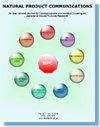越南 Knema globularia 中的一氧化氮生成抑制剂:体外和硅学研究
IF 1.4
4区 医学
Q4 CHEMISTRY, MEDICINAL
引用次数: 0
摘要
目的:Knema 属植物含有多种具有药理潜力的天然次生代谢物,包括抗肿瘤、神经保护、抗糖尿病和保肝活性。本研究的重点是从越南 Knema globularia 中鉴定一氧化氮生成抑制剂。方法:采用多种色谱技术分离次生代谢物。利用核磁共振(NMR)光谱测定了它们的化学结构,并与已发表的文献进行了比较。使用格里斯试验评估了其抗炎效果,并通过对接研究调查了蛋白质之间的相互作用。结果:根据其抗炎活性,从越南 K. globularia 中分离出了六种化合物(1-6)。经鉴定,这些化合物分别为羽扇豆醇(1)、福莫宁(2)、isiquiritigenin(3)、2-[4-(3-羟基丙基)-2-甲氧基苯氧基]丙烷-1,3-二醇(4)、(+)-儿茶素(5)和(-)-表儿茶素(6)。化合物 1、3 和 4 是首次从越南 K. globularia 中发现。所有分离出的化合物都针对脂多糖(LPS)诱导巨噬细胞 RAW264.7 产生一氧化氮(NO)进行了测试,以评估其抗炎潜力。化合物 5 的抑制活性最高,IC50 值为 5.61 μM,其次是化合物 3 和 6,IC50 值分别为 6.76 和 11.52 μM。然而,化合物 1、2 和 4 显示出了非活性,其 IC50 值超过了 30 μM。随后,研究人员采用分子对接法研究了化合物 3、5 和 6 与诱导性一氧化氮合酶 (iNOS)、环氧化酶-2 (COX-2) 和白细胞介素-8 (IL-8) 等参与炎症的蛋白质之间的亲和力和相互作用,并进行了 ADMET(吸收、分布、代谢、排泄和毒性)预测。结论这些研究结果表明,从越南球果中提取的活性成分具有作为抗炎药物的潜力,值得进一步探索和开发。本文章由计算机程序翻译,如有差异,请以英文原文为准。
Nitric Oxide Production Inhibitors from Vietnamese Knema globularia: An in Vitro and in Silico Study
Objective: The Knema genus contains various naturally occurring secondary metabolites with pharmacological potential, including antitumor, neuroprotective, antidiabetic, and hepatoprotective activities. This study focuses on identifying nitric oxide production inhibitors from Vietnamese Knema globularia. Methods: The secondary metabolites were isolated using several chromatographic techniques. Their chemical structures were determined using nuclear magnetic resonance (NMR) spectroscopy and compared with published literature. The anti-inflammatory effect was evaluated using the Griess assay, and protein interactions were investigated through docking studies. Results: Based on their anti-inflammatory activity, six compounds (1-6) were isolated from Vietnamese K. globularia. These compounds were identified as lupeol (1), formononetin (2), isoliquiritigenin (3), 2-[4-(3-hydroxypropyl)-2-methoxyphenoxy]propane-1,3-diol (4), (+)-catechin (5), and (−)- epicatechin (6). For the first time, compounds 1, 3, and 4 were reported from Vietnamese K. globularia. All isolated compounds were tested against lipopolysaccharide (LPS)-induced nitric oxide (NO) production in macrophage RAW264.7 cells to assess their anti-inflammatory potential. Compound 5 exhibited the highest inhibitory activity, with an IC50 value of 5.61 μM, followed by compounds 3 and 6, with IC50 values of 6.76 and 11.52 μM, respectively. However, compounds 1, 2, and 4 showed inactivity with IC50 values exceeding 30 μM. Molecular docking was then employed to investigate the affinity and interactions between compounds 3, 5, and 6 and proteins involved in inflammation, such as inducible nitric oxide synthase (iNOS), cyclooxygenase-2 (COX-2), and interleukin-8 (IL-8), along with ADMET (absorption, distribution, metabolism, excretion, and toxicity) predictions. Conclusion: These findings suggest that the active constituents derived from Vietnamese K. globularia have the potential as anti-inflammatory agents worthy of further exploration and development.
求助全文
通过发布文献求助,成功后即可免费获取论文全文。
去求助
来源期刊

Natural Product Communications
工程技术-食品科技
CiteScore
3.10
自引率
11.10%
发文量
254
审稿时长
2.7 months
期刊介绍:
Natural Product Communications is a peer reviewed, open access journal studying all aspects of natural products, including isolation, characterization, spectroscopic properties, biological activities, synthesis, structure-activity, biotransformation, biosynthesis, tissue culture and fermentation. It covers the full breadth of chemistry, biochemistry, biotechnology, pharmacology, and chemical ecology of natural products.
Natural Product Communications is a peer reviewed, open access journal studying all aspects of natural products, including isolation, characterization, spectroscopic properties, biological activities, synthesis, structure-activity, biotransformation, biosynthesis, tissue culture and fermentation. It covers the full breadth of chemistry, biochemistry, biotechnology, pharmacology, and chemical ecology of natural products.
Natural Product Communications is a peer reviewed, open access journal studying all aspects of natural products, including isolation, characterization, spectroscopic properties, biological activities, synthesis, structure-activity, biotransformation, biosynthesis, tissue culture and fermentation. It covers the full breadth of chemistry, biochemistry, biotechnology, pharmacology, and chemical ecology of natural products.
 求助内容:
求助内容: 应助结果提醒方式:
应助结果提醒方式:


